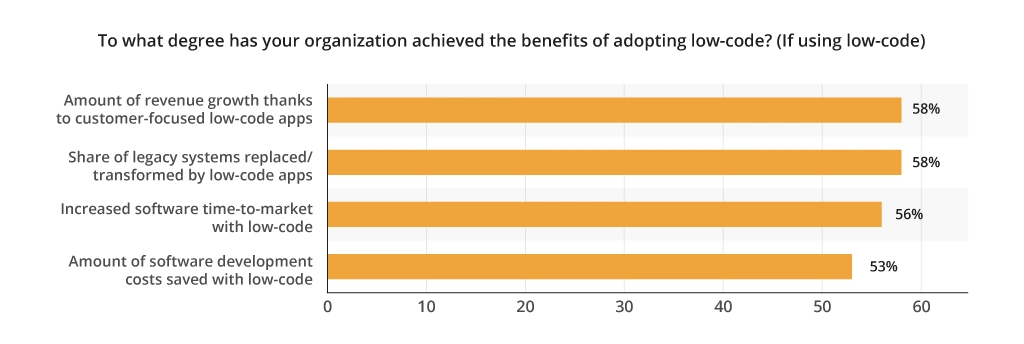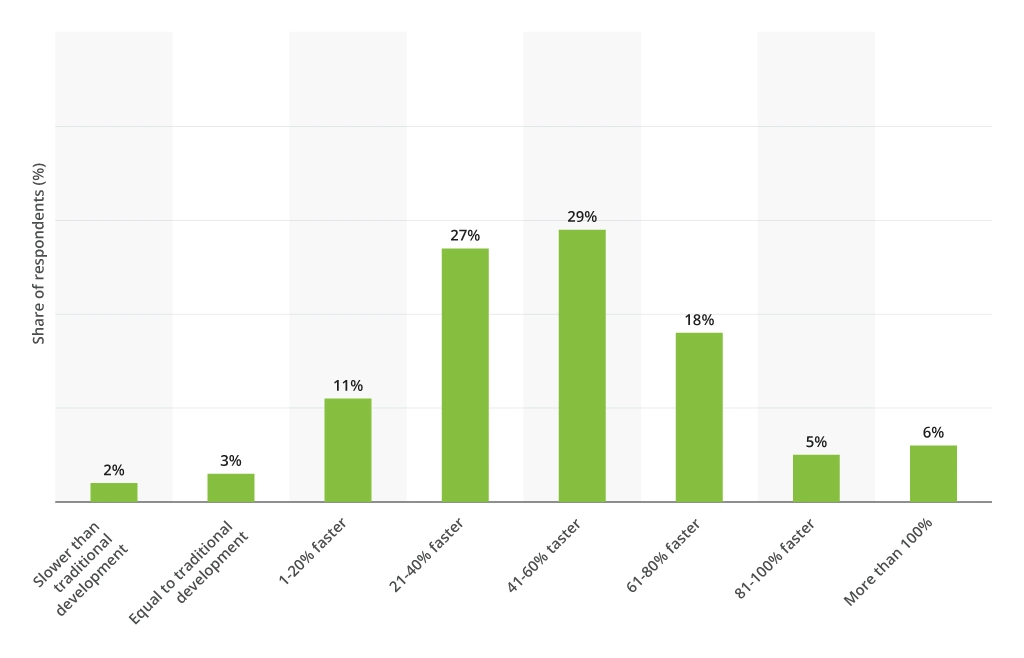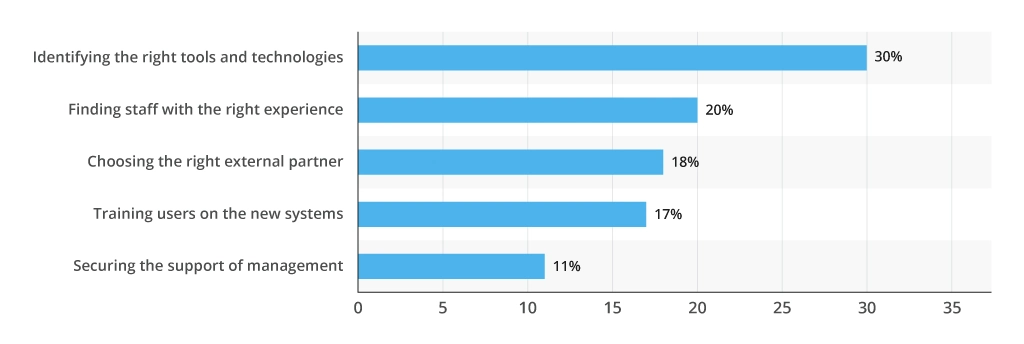Custom Development vs Low-Code in Today's Digital Landscape
Two approaches, one goal. The ever-evolving nature of software development has led to a big new choice: go traditional with building custom solutions or opt for low-code.
With the push for the shortest time-to-market, more and more organizations are opting for the low-code. In fact, 94% of business leaders are already employing the low-code approach one way or another.
This blog post explores key differences, advantages, and considerations of the two software development approaches, shedding light on how they can coexist and complement each other in today's fast changing tech environment.
Understanding Custom Dev
Custom development involves creating software from scratch attuned to a specific business and industry. With a complete customization and control over the features and functions, it grants the freedom to shape software precisely according to the company’s unique needs — with no limitations and compromises.
For instance, the healthcare facility may require a bespoke electronic medical record (EMR) systems to ensure efficient patient management, while manufacturing companies benefit from custom production management software to optimize their operations. Presently, the custom software development market is expected to hit a whopping USD 146.18 billion by 2030.
Case in point. Our client, a global agricultural leader, opted for a custom development approach to create a React Native mobile application, that was successfully implemented by Infopulse. The tailor-built solution digitized the silage analysis process, offering user-friendly data collection forms, offline functionality, and seamless synchronization with the backend. In this case, choosing custom development ensured an optimal fit for their unique operational landscape, showcasing the power of customization in addressing industry-specific challenges.
Exploring Low-Code Development
Low-code development is an approach that simplifies and accelerates the process of building applications by using visual interfaces and pre-built components. With less coding involved, it transforms the way developers and users collaborate, paving the way for citizen developers – non-technical users who create apps. That does not mean, however, that developers as we know them today will become obsolete.
Citizen developers leverage the drag-and-drop of low-code to whip up the necessary solutions in a matter of days. Yet, they still work alongside professional developers who provide support for quality assurance, tech issues, and guidance. While citizen developers focus on business logic, professionals handle complex integrations, security checks, and optimization. This collaboration reduces the gap between IT and business, maximizing productivity and delivering effective solutions.
So, today low-code is taking the software development world by storm, with the market size projected to reach an impressive USD 148.5 billion by 2030. This surge in popularity is evident, as 77% of organizations have already embraced this tool as part of their software building strategy. Industry professionals have taken notice of the trend too, with 75% of IT professionals considering low-code a crucial factor in their operations. Among other significant benefits of its adoption, organizations indicate an outstanding 53% reduction in costs. More about the benefits in our dedicated article.
Case in point. Infopulse chose low-code development using Microsoft Power Apps to create a customized inspection management solution for a leading European research company. The decision to opt for the low-code was aimed at speeding up the process and making it more flexible. This approach allowed for easy customization, fast implementation of features like offline access and Azure integration and ensured the project could adapt to the client's needs while maintaining efficiency and functionality.
Comparing Custom Dev and Low-Code
Both approaches have their own distinct attributes, and grasping these contrasts is essential to pick the one that works best for your solution. Let's explore what sets the two development concepts apart.
1. Mastery of Coding
Custom solutions demand a certain skillset and experience with coding languages and frameworks to be able to craft solutions from the ground up, tailor-made for your unique business demands. In contrast, low-code offers a simplified route, making innovation accessible to a wider spectrum of stakeholders. It still involves training to use the low-code platform to its full potential, but the learning curve is not as steep. With the help of a service provider, it is possible to establish your own in-house competence center for low-code development and reap the benefits of speed-up development.
2. Speed to Market
Custom development is meticulous and deliberate, taking time to ensure the solution is aligned with your vision. However, some projects are more about speed than fine-tuning. Intuitive interface and pre-built modules of a low-code platform facilitate rapid prototyping and deployment, capitalizing on today’s agile business landscapes. Power Apps, for example, has more than 300 ready-to-use connectors at your disposal.
Developers and businesses alike enjoy low-code ease of use and quicker time-to-market. In 2021, nearly one-third of respondents from a global survey stated that using low-code is between 40% and 60% faster than conventional development methods.
For instance, to create a mobile application for our client, Infopulse went for the low-code approach. With all of the required features and capabilities, we developed a full-scale grain balance management application in just 12 weeks for a major agro-technical company.
3. Flexibility and Scalability
Custom development offers high flexibility and scalability. Your application is a bespoke masterpiece, shaped to your precise requirements and ready to scale with your enterprise. Meanwhile, low-code, while fostering agility, might need creative workarounds for complex business scenarios and large-scale expansions.
4. Financial Frontiers
Embracing custom application creation involves a financial commitment, considering the substantial investment in skilled manpower and resources. The low-code alternative minimizes upfront costs, thanks to its modular nature and streamlined development process. However, it may require more licensing investments along the way.
5. Maintenance
Custom solutions demand continuous upkeep and enhancements to adapt to evolving technologies and the changes in infrastructure. In contrast, lLow-code solutions lighten this burden to some extent, with platform providers handling updates and compatibility allowing your team to channel efforts where they matter the most. However, it doesn’t mean that low-code applications can be left unattended, just that they require a bit less effort.
6. Unveiling Unique Solutions
Custom development thrives on crafting unique solutions to intricate business challenges. Your application is a canvas, designed without constraints. Low-code, while versatile, shines brightest in streamlining conventional processes.
7. The Shield of Security
Building a custom application provides a security fortress as many modern solutions adopt the security-by-design methodology, ensuring data integrity and compliance from the get-go. Low-code, though secure, leans on standardized components, potentially offering less granularity in security adaptations.
Overall, your choice echoes through your business's trajectory. Custom approach unfolds endless possibilities but requires time and resources. Using low-code is the expressway, delivering agility and innovation. Delve into your enterprise's heartbeat and align your path with your aspirations. The journey is yours; make it resonate with your vision. For your ease, we have compared the two software development approaches based on their key characteristics.
Characteristics/ Features
Custom Dev
Low-Code
Coding knowledge required
High
Medium
Time-to-market/development speed
Medium
High
Scalability & flexibility
High
Low
Upfront cost
High
Low
Maintenance need
Medium
Medium
Customization
High
Medium
Security
High
High
Finding the Right Balance: Custom Dev and/or Low-Code
Although having its advantages and application in a wide range of use cases and industries, low-code may not be suitable for every scenario. This approach is particularly useful for more conventional solutions, including internal workflow management, CRM systems, internal knowledge bases, wikis, and event management.
To exemplify, if we need to create a tracking application for a private airport with a few daily flights or a simple employee request approval form – low-code emerges as the ideal solution. Another scenario for low-code is translating Excel files into interactive applications. Given the extensive data typically accumulated by organizations over time, leveraging low-code to categorize, access, and analyze it helps build a seamless business process previously buried in columns of files.
When faced with tasks requiring the management of extensive real-time data, intricate user interfaces, and concurrent use by numerous users, the most sensible choice is building a custom solution. Also, if your aim is to craft an innovative solution that differentiates you in the market, custom development maintains the upper hand.
Here comes the question: does it have to be only one? Actually, no, since custom dev and low-code each serve their own purpose and have their niche in the corporate IT landscape. Combining the two is often the most advantageous approach, when you can reap the benefits of both tailored solutions for complex challenges and efficient application creation for standard processes. Overall, striking the perfect balance between custom and low-code solutions depends on several factors.
Considerations for Choosing Between Custom Dev and Low-Code
Embarking on application modernization can indeed present its challenges, as attested by 93% of respondents. One of the major hurdles is deciding which approach to use for the modernization process.
When faced with the decision of whether to pursue custom development or opt for low-code solutions, several critical factors come into play, each with its own significance.
- Complexity and functional requirements. Understanding the complexity of the project and what business objectives it should meet is crucial. As we already know, custom application development offers the flexibility to address intricate and specific requirements, while low-code solutions are better suited for less complex projects.
- Non-functional requirements. When designing an application, organizations should also consider not only what it should do but how it will achieve the objectives and who will use it. Bespoke solutions are an obvious choice for high-performing, customer-facing applications that support multiple processes simultaneously. On the contrast, low-code is typically employed to streamline internal processes for selected teams. Other requirements to consider are your expectations of scalability, availability, and reliability of the solution.
- Skillsets and resources. Low-code solutions may allow non-technical users to actively contribute, whereas building a custom product typically requires a higher level of technical expertise, which can be supplied by the IT provider rather than outstaffed.
- Cost considerations. Cost is an essential factor to weigh in. Custom development often entails higher upfront costs due to specialized expertise, while low-code solutions can offer cost savings by reducing the need for extensive coding. However, everything is not so straightforward, as factors such as licensing and maintenance can influence the cost in the long-term.
- Level of control and ownership. Determine the desired level of control and ownership over the application. Typically, custom development gives complete control and customization, while low-code solutions may have predefined templates and components, limiting customization options.
By taking these factors into consideration, you will be able to make an informed choice that will align with the specific project goals and constraints of your project.
Conclusion
The rise of low-code development is fueled by the demand for faster time-to-market and increased user control. However, building a custom application remains valuable for businesses seeking complete control and scalability. When choosing between custom solutions and low-code platforms, consider project requirements, timeline, and budget. Low-code platforms offer speed and simplicity, while custom development excels in customization and control. Ultimately, the right approach depends on your specific business needs.
![Custom Development vs Low-Code [banner]](https://www.infopulse.com/uploads/media/banner-1920x528-custom-development-vs-low-code.webp)







![Cloud Native vs. Cloud Agnostic [thumbnail]](/uploads/media/thumbnail-280x222-cloud-agnostic-vs-cloud-native-architecture-which-approach-to-choose.webp)
![DevOps Adoption Challenges [thumbnail]](/uploads/media/thumbnail-280x222-7-devops-challenges-for-efficient-adoption.webp)
![White-label Mobile Banking App [Thumbnail]](/uploads/media/thumbnail-280x222-white-label-mobile-banking-application.webp)

![Mortgages Module Flexcube [Thumbnail]](/uploads/media/thumbnail-280x222-Secrets-of-setting-up-a-mortgage-module-in-Oracle-FlexCube.webp)
![Challenges in Fine-Tuning Computer Vision Models [thumbnail]](/uploads/media/thumbnail-280x222-7-common-pitfalls-of-fine-tuning-computer-vision-models.jpg)
![Pros and Cons of CEA [thumbnail]](/uploads/media/thumbnail-280x222-industrial-scale-of-controlled-agriEnvironment.webp)
![BPO in Telecom and BFSI [Thumbnail]](/uploads/media/thumbnail-280x222-ways-business-process-outsourcing-bpo-can-help-telecom-bfsi-and-other-industries-advance.webp)
![Cloud-Native Maturity Model Assessment [thumbnail]](/uploads/media/thumbnail-280x222-what-Is-the-cloud-native-maturity-model-definition-and-assessment-criteria.webp)
![Power Platform for Manufacturing [Thumbnail]](/uploads/media/thumbnail-280x222-power-platform-for-manufacturing-companies-key-use-cases.webp)